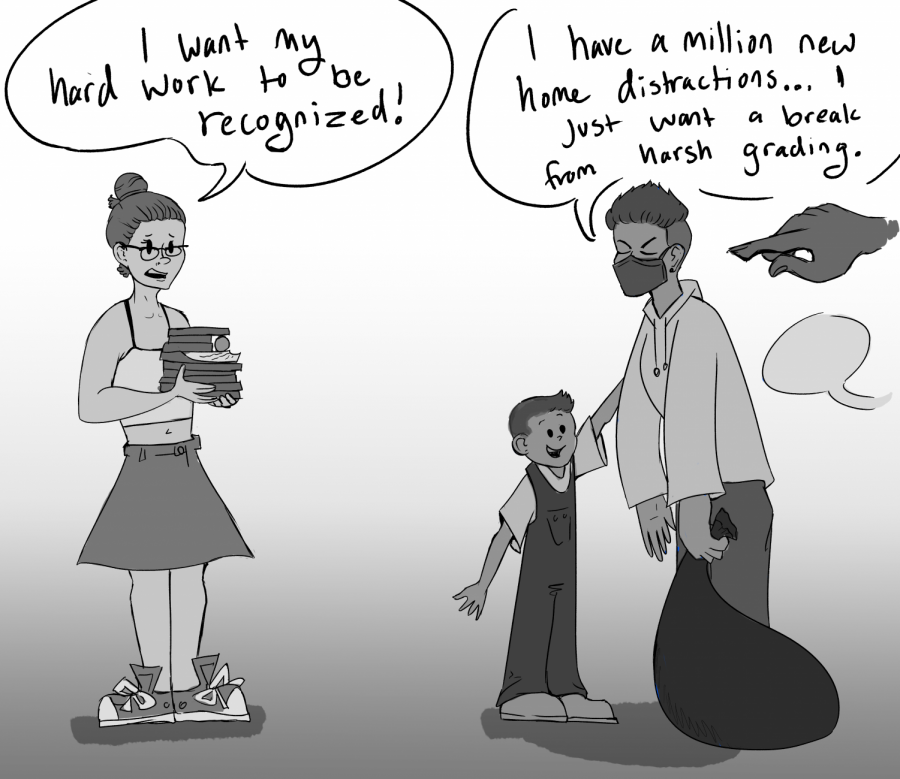Pro vs Con: Is the New No Credit or Credit Grading Policy Beneficial?
May 9, 2020
Pro: Emma Leibowitz
April 15 the Acalanes Union High School District (AUHSD) Governing Board decided that students in the district will receive credit or no credit marks for the second semester instead of a mark of pass or no pass for the fourth quarter with the existing letter grade from the third quarter. This came as a shock to many who advocated for the district to allow students to showcase third-quarter letter grades on their transcripts along with a mark of pass or no pass for the fourth quarter. Superintendent John Nickerson affirmed the credit or no credit policy for the second semester in an email sent on April 17. However, although many students and parents disagree, the credit or no credit policy has benefits to students and can help ease tensions during this time of school closure and COVID-19.
In the April 17 email addressed to AUHSD parents and guardians, Nickerson discussed the concerns expressed by many regarding the new grading policy. “The third-quarter grade is only designed as a progress report, and we have determined that there are significant inconsistencies in how the teachers use this progress report and what the grade represents,” Nickerson said. The district and administration came to the decision of using credit or no credit grades to compensate for potential difficulties students might encounter at home or with technology using distance learning. “We didn’t want to grade students and have those grades reflect circumstances that are out of our control or the control of the students. If a student has a parent who is unemployed or a family member who is very sick, those things would absolutely impact the capacity to perform, and it would be unfair,” principal Julie Parks said.
Although attractive to some, third-quarter grades are not complete illustrations of a student’s capabilities, especially since grades are reset at the start of the second semester, allowing most students to maintain higher grades in the third quarter since they begin with a clean slate. “Allowing students to improve a third-quarter grade is also fraught with challenges and issues of inequities given the wildly different circumstances we all experience with the pandemic,” Nickerson said. Using third-quarter grades is not only ineffectual, but it is also inaccurate and does not show a true representation of students’ abilities, which creates more disparities.
Additionally, colleges and universities will not be regarding students differently based on their “credit” grades. Admissions offices around the country are changing their requirements and observing the issues brought to light during the pandemic. “We understand that disruptions may significantly alter the trajectory of their extracurricular, athletic and other pursuits…Their college applications will likely look different than they have in the past,” Columbia University explained on their website. University of California (UC) schools have removed their SAT/ACT requirement for fall 2020 applicants. Colleges and universities are adapting to become accepting of the challenges of coronavirus, so students do not need to worry about being at a disadvantage. “There has not been a single college that has come out saying that they would penalize students who had credit or no credit for this semester on their transcripts. The vast majority of schools throughout our country are shut down right now, so that mark is going to show up on many transcripts of many students,” Parks said.
Many people are worried that colleges will not be able to gain a clear representation of a student’s academic capabilities based on the credit system, but admissions offices are actually prepared to deal with many different styles of grading based on the applicant’s high school system. “Colleges take the school profile that outlines how grades and GPA are calculated, and they use that to adjust to the different transcripts they see to try to create one even playing field to compare students across many different schools,” Parks said.
The Mercury News reported that districts across the Bay Area reached similar decisions regarding grading policies. The pass/fail system is preferable to a policy of giving letter “A” grades to every student for the second semester, which would only supply false positives on transcripts and dilute the accuracy of grades. The San Francisco Unified School District proposed to implement this type of “A-only” grading, according to the Mercury News, which will dissuade students from working hard and punish those who legitimately earned high letter grades. It’s better for students to receive credit or no credit grades for the second semester and display third-quarter grades separately on a college application if they choose.
Attempting to incorporate third-quarter letter grades into the second-semester transcript is difficult and harmful to students with high third-quarter grades. By allowing students with lower grades to improve their averages, students with better grades will be less distinguished in the eyes of college and university admissions officers. Using the credit or no credit policy, students can rely on the work they put in during the first semester to showcase their talents, instead of trying to justify their successes with progress reports like third-quarter grades. Although there has been much debate over this new policy, it is probably one of the best options for upholding academic integrity while still providing support and leniency for students during this difficult time. Students and parents should not attempt to change the AUHSD policy of credit or no credit grades because it is the best overall system at this time.
Con: Jonathan Pham
According to a petition on Change.org, over 1000 Acalanes Union High School District students and parents fought to have the choice between using a modified third-quarter grade or credit or no credit for the second semester transcripts. This petition sparked when AUHSD decided to switch credit or no credit for the second semester. The AUHSD distance learning guidelines state that all students will receive either credit or no mark for the second semester overall grade. If the AUHSD governing board decided that all students’ second semester transcripts would be based around their third-quarter grades, some students would benefit while others would not as students had varying results during the third quarter. The same goes for the credit or no credit policy as it essentially erases the hard work of some students during the third quarter as it will not be displayed on their second semester transcripts. Therefore, giving the choice between either grading policy benefits all students as they can decide which policy would help them more.
To the petitioners’ dismay, the board decided on April 15 that the district would continue with credit or no credit for the fourth quarter. Though some students may benefit from this policy, many prefer receiving their improved upon third-quarter grade to show for the second semester.
“I hate that I worked so hard for all of third quarter just to have those grades simply mean nothing. I had the best grades I’ve had all of high school during the third quarter and it won’t get to show on my transcript. I find it frustrating that we don’t at least get to choose. Now, an A, B, C, or D is all the same under credit or no credit,” sophomore Chris Morrison said.
Now that the UC system no longer requires standardized testing for the class of 2021 applicants, grade point average (GPA) matters more than ever in an application. Taking away the second semester leaves the class of 2021 with their sophomore year, half of their junior year, and a portion of their senior year deciding their futures. “I think it’s unfair because some of the largest school districts in California are offering the choice to their students. Even though the UC’s are accepting only credit, we still have less that contributes to our GPA. Additionally, private schools are much stricter and it would be beneficial for us to receive more substance to our GPA to better represent us,” junior Matt Lyons said.
According to the petition on Change.org, a multitude of California school districts already authorized “harmless policies” in which one’s second semester grade will be no lower than that of the third quarter. Seven out of ten of the largest districts, including Elk Grove, Sacramento City Unified, Corona-Norco, Los Angeles Unified, San Diego Unified, San Bernardino, and Fresno Unified established the “harmless” policies while an additional two others within the group are involved in the discussion. Additionally, 37 more districts all followed suit in giving their students the choice between credit or no credit and a revised third-quarter grade for their second semester transcripts.
“Motivation is an issue. Shifting the focus from being motivated toward the grade to being motivated just to learn is a big mindset shift, and I think it’s likely we will see a decline in motivation from that,” Julie Parks said. While students are in school to learn, grades are also a very important factor as they decide their futures. With the removal of grades from the second semester transcripts, students lose their motivation. Giving students the ability to improve upon their third-quarter grades for the second semester gives students the incentive to apply more effort during distance learning.
“Personally, I don’t think it makes any sense for me to try as hard when I’m not working towards a grade. I don’t see all of my classes as very important to my future, rather I see the grades as what will get me to college. I know a lot of my peers think the same thing too,” sophomore Dominic Clerici said.
Additionally, students taking AP classes no longer receive the boost to their GPA from the second semester. This is especially unfair because AP students prepare through the quarantine for the AP exams as they would be doing in normal school but they no longer receive the extra bump to their GPA. “The new changes are not entirely fair to all students. Taking AP Euro, I think we should either get the choice between the two policies, or some sort of alternative benefit for students taking AP classes,” sophomore Giri Mase said.
Many parents support the switch to having a choice between the two policies as well. They saw first hand, the work their kids put in and want it to show on their transcripts. “It is unfortunate that students, through no fault of their own, don’t at least have the option to use their hard earned third-quarter grades for their second semester transcripts,” Wayne Hill, father of two Miramonte students, said.









